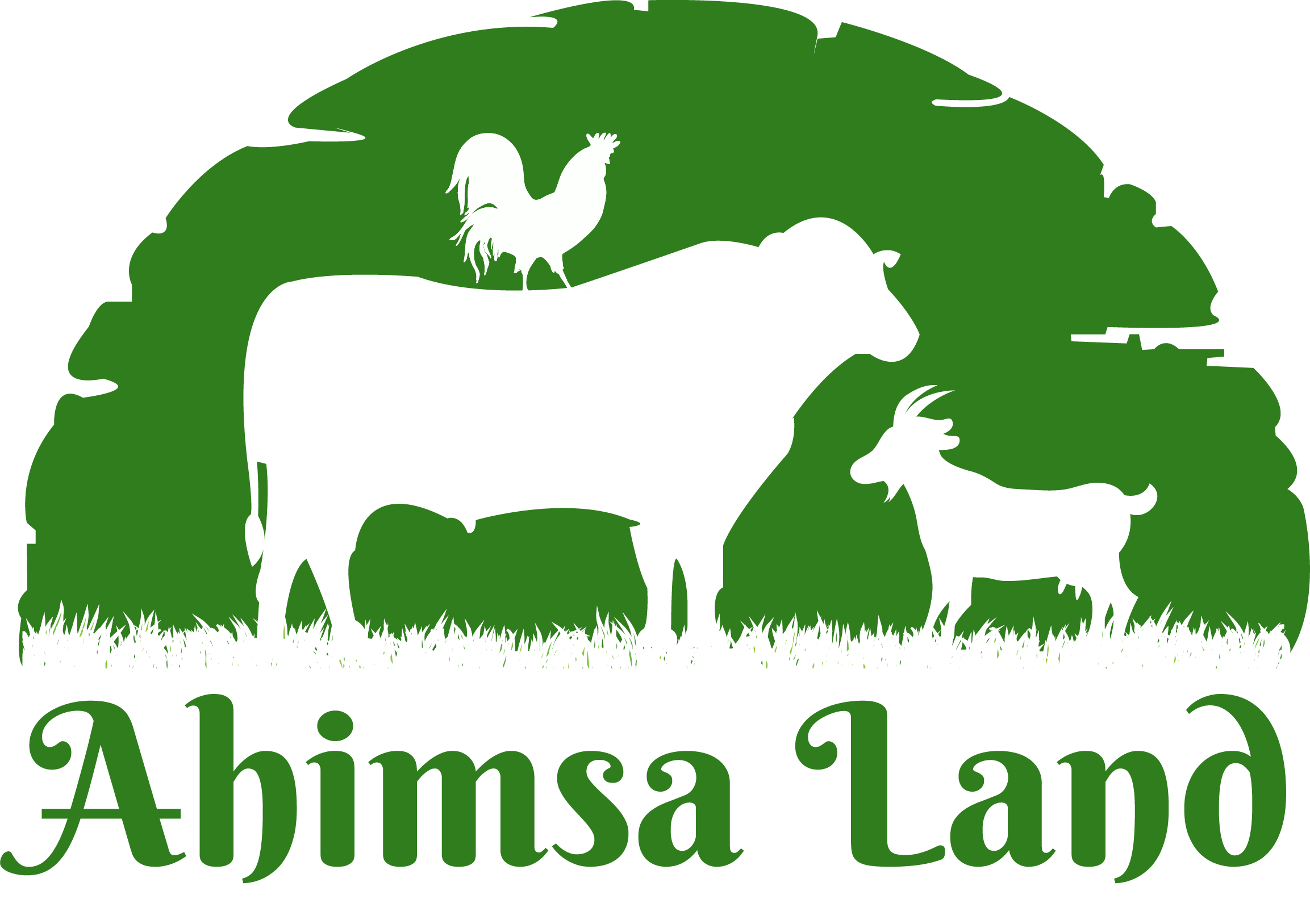Dairy and Greenhouse Gas Emissions
Climate change is no longer a topic reserved to the side lines of journals. We have all experienced it already with simple observations like, “This year the rains continued till the end of October. It’s never happened before.” Or “It isn’t really cold this winter, but it was unusually cold in February, wasn’t it?” Or the news reporting that certain cities experienced unbearably high temperatures ever. We’ve either experienced, read or heard about more frequent and intense droughts, storms, heat waves, wildfires, rising sea levels, melting glaciers and warming oceans and we know that these have directly harmed animals, hastened the extinction of species, destroyed the natural habitats of many species, and wreaked havoc on our communities and livelihoods. And it’s true for all continents and countries with the news of wildfires in the pristine forests of America and Australia being especially distressing to watch with feelings of hopelessness and helplessness at the fore.
Earth’s temperature rose by 0.08° Celsius per decade from 1880 till 1980, but the rate of warming since 1981 is more than twice that: 0.18° C per decade. 2021 was the 7th consecutive year (2015-2021) where global temperature has been over 1°C above pre-industrial levels. This is caused by greenhouse gases that trap heat in the atmosphere. Each of these gases can remain in the atmosphere for different amounts of time, ranging from a few years to thousands of years. Since all of these gases remain in the atmosphere for a long time, they become well mixed and the amount that is measured in the atmosphere is almost the same all over the world and impacts all of us regardless of where each one originated from.
Some gases heat up the planet more than others and cause the Earth’s blanket to become denser leading to many other changes around the world—in the atmosphere, on land, and in the oceans. These are the same experiences we have had of floods, droughts, wildfires, tsunamis, storms, cyclones, etc.
For each greenhouse gas, there is a Global Warming Potential (GWP) to compare the global warming capacity of each gas. This is a measure of how much energy the emissions of 1 ton of a gas will absorb over a certain period of time, in comparison to the emissions of 1 ton of carbon dioxide (CO2). Gases with a higher GWP absorb more energy, per pound emitted, than gases with a lower GWP, and thus we know which gases contribute more to warming Earth.
Greenhouse Gases at a Glance
We are going to look at the three key greenhouse gases that contribute to climate change: carbon dioxide (CO2), nitrous oxide, and methane. The other two major gases that also cause global warming are chlorofluorocarbons and water vapour. Of the global manmade greenhouse gas emissions, CO2 is the highest contributor with about 76 per cent of total greenhouse gas emissions. Methane, mostly from agriculture, accounts for 16 percent of greenhouse gas emissions and nitrous oxide, both from industry and agriculture, is responsible for 6 percent of global emissions.
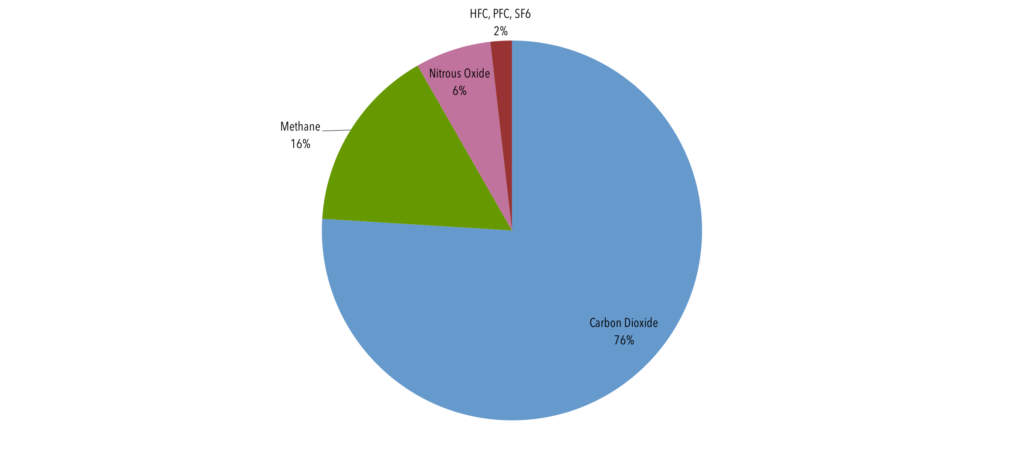
Overall, it is estimated that the animals that we humans exploit in the name of food end up being responsible for 14.5 per cent of all greenhouse gas (GHG) emissions from human activities. Globally, cows and buffaloes in the animal husbandry sector are the cause for the largest amount of emissions amounting to around 65 per cent of total emissions of this sector. Also, with increased sales of milk, the dairy and cattle industry’s GHG emissions increased by 18 per cent between 2005 and 2015 according to the the United Nations’ Food and Agricultural Organization (FAO). So where does the Indian dairy industry stand? Around 16% of India’s GHG emissions come from agriculture, and a large percentage of this comes from methane produced by mostly cows and buffaloes. We must note that India has the largest dairy herd in the world with India transitioning from a country with a deficiency of milk a few decades ago to now the largest producer of milk in the world. So, what’s the dark side to this “progress”? You see, cows and buffaloes exploited for milk release all three major GHG gases: methane, CO2, and nitrous oxide. Cows and buffaloes release methane naturally through a process known as enteric fermentation, nitrous oxide is generated during manure storage and disposal, and CO2 is produced during feed production, and the manufacturing and transporting of milk and milk products.
Dairy Animals and Methane
Methane is a short-lived but powerful greenhouse gas and is the second-largest contributor to climate change. The majority of methane emissions caused by human activity comes from the animals we exploit in the name of milk and meat. The scary fact is that though the rate of increase in carbon dioxide emissions reduced during the Covid-19 pandemic lockdowns of 2020, methane (CH4) emissions in the atmosphere increased sharply. Around 32 per cent of human-caused methane emissions are released by the gastroenteric process and manure of ruminant animals like cows, buffaloes and goats as these animals rely on bacteria to break down the plants that they eat. A fully grown cow can release up to 500 litres of methane into the atmosphere each day mostly through burps and the rest as flatulence. There are roughly 1 billion cattle around the world with India holding 303,760,000, which is almost 30% of the worldwide cattle population. Imagine what that means for India. Imagine what that means for India which has 15% of the worldwide cattle population. With a dairy herd population of almost 30.4 crore cows and buffaloes as of 2021 that amounts to around 15,188 crore litres of methane every day! And this doesn’t even include all the calves that are still growing. It’s not surprising then that methane emissions from cattle in India amount to 75.4 per cent of the total greenhouse gas (GHG) emissions in India, the highest of all GHG emissions.
Unlike CO2, which remains in the atmosphere for thousands of years, methane has a relatively short lifespan breaking down after just 12 years. Due to its chemical composition, methane is remarkably effective at trapping heat, trapping roughly 25 times more heat than carbon dioxide over a period of 100 years, and with a global warming potential 80 times more than that of carbon dioxide over a 20-year period, methane is responsible for around 30 per cent of the rise in global temperature since the industrial revolution. The dangerous consequence is that the concentration of methane in our atmosphere is edging us ever closer to the 2°C tipping point.
Dairy Animals and Nitrous Oxide
Nitrous oxide (N2O) is another one of the main greenhouse gases and has a high atmospheric life span of almost 109 years affecting not only our present generation but also future ones. Once again the agriculture sector has been the biggest contributor to nitrous oxide (N2O) emissions in India accounting for 84 per cent of the total with the urine and dung of cows and buffaloes being the major sources of the production and emission of this gas. N2O emissions from cattle in India contribute 13.6 per cent of all GHG emissions from cattle in India.
When cows and buffaloes graze, they convert the nitrogen present in the plants they eat into highly reactive nitrogen, which is mostly passed out in the urine and which gets deposited in the soil. When the urine reacts with the soil, it ends up in the production and emission of large quantities of nitrous oxide due to the soil microbial processes of nitrification and denitrification. The amounts of nitrogen deposited in the soil are also much more than plants require to grow well, which ends up with the extra being released into the environment in the form of nitrate leaching, ammonia vapours, nitrous oxide and nitrogen gas. And all of these, except nitrogen gas, are the cause of climate change. The greenhouse gasses released from the open decomposing manure also cause major environmental degradation increasing proportionately with the increasing period of grazing. In India, each adult cow produces approximately 10-11 kg of dung and 7-10 litres of urine, and an adult buffalo produces around 15 kgs dung and 15 litres of urine per day. As per Subhash Palekar’s natural farming method, also called Zero Budget Natural Farming (ZBNF), in which he uses cow dung and urine, one cow is capable of fertilizing the soil of 30 acres of land every month. Considering India exploits the largest number of cows and buffaloes in the world in the name of milk (most of the flesh is exported once the cow/buffalo can no longer produce a profitable amount of milk), the figures are catastrophic when we consider N2O emissions from this source. Explicitly, India with an arable land area of 394,600,000 acres would need only 13,153,333 cows if we followed Subhash Palekar’s method, but we have 303,760,000 cows and buffaloes at present which is more than twenty three times over!
Dairy Animals and Carbon Dioxide
The current global atmospheric concentrations of carbon dioxide are unprecedented compared with the past 800,000 years, even after taking into consideration natural fluctuations. Emissions of CO2 in dairy operations are majorly from feed production for animals exploited for milk with the highest emissions borne by lactating cows, buffaloes and replacement cows. Emissions of CO2 from cows contribute 11.0 per cent and buffalo 8.2 per cent of the total GHG emissions of animals exploited for their milk. Feed production for such animals is also the cause of CH4 and N2O emissions with all three totalling to 17.3 per cent of the total GHG emissions from this sector. In order to get the most profits out of these exploited animals, farmers feed them processed feeds including cattle feed and oilseed meals, for which fertilisers, pesticides, and fossil fuels are used during the production process. Besides these emissions, there are also CO2 emissions from the combustion of fossil fuel to power farm machinery, the production, processing and transportation of the feed, milk and other milk products.
The Solution: Combating Climate Change with Climate Friendly Farming
How do we combat the impact of these harmful gases? It’s quite clear that we need to move away from animal husbandry and so the obvious answer would be to reduce climate change through different farming practices, wouldn’t it? Fortunately we know that fruits and vegetables, whole grains, beans, peas and legumes, lentils and nuts and seeds on the whole use much fewer precious resources like energy, land, and water, and have much lower greenhouse gas emissions than foods procured by exploiting animals.

Credit: UN Climate Action
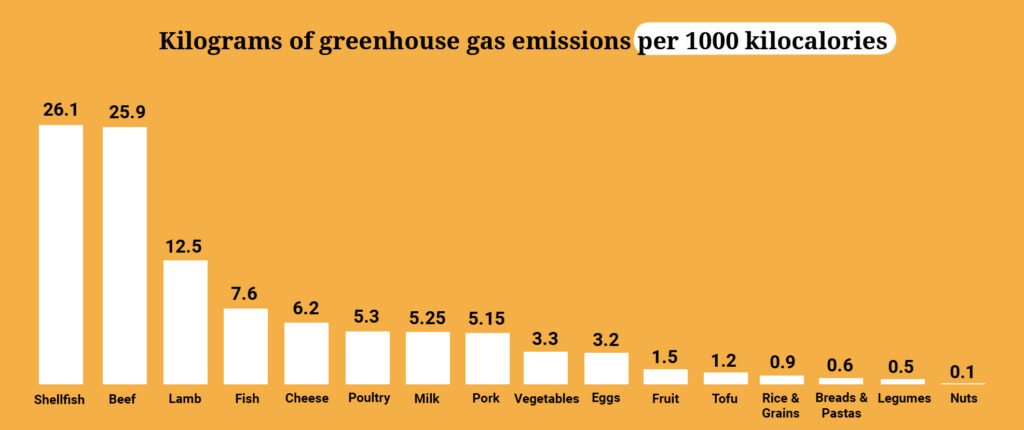
Credit: UN Climate Action
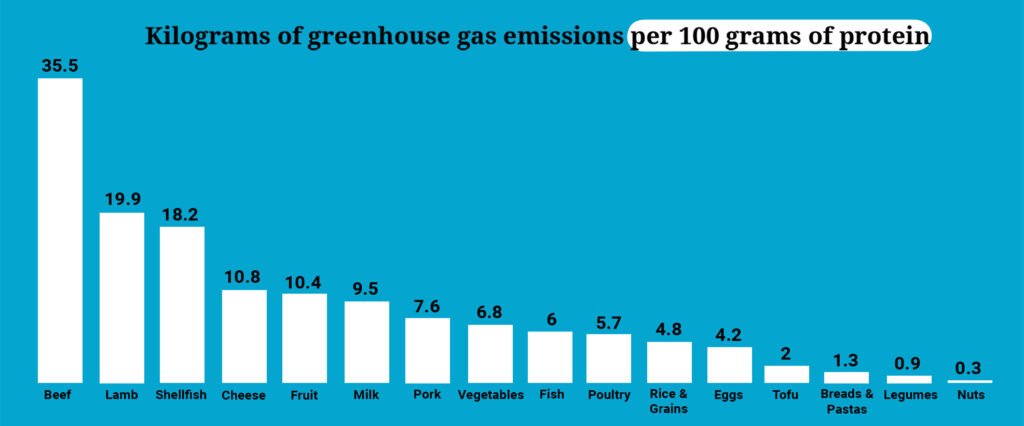
Credit: UN Climate Action
A human on average needs around one and a half to two and a half kilograms of food per day and fruits and vegetables are the ones that emit the least amount of GHGs. Consumers can also do their bit to take care of human hunger and food sustenance more easily and with much less impact on the planet by switching to a plant-based diet and it’s especially easy to do that in India with our traditional diet of roti, sabji, dal, chawal, salads, chutneys, papad and pickle.

Because the larger part of our population is employed in agriculture and with with 70 million farmers tied to the dairy industry in India, it is imperative for farmers, including landless farmers, to move away from the dairy industry and to climate friendly sources of income. Also, with most Indian farmers holding only a small number of cows and buffaloes, the carbon footprint is almost always greater per litre of milk, which is because these cows usually produce less milk than those in intensive dairy farms and the methane and nitrous oxide emissions of animals from both kinds of farms are almost always the same. Moreover, dairy isn’t as economically profitable as it is made out to be. If dairy farmers don’t switch to more climate friendly sources of income, it will in all probability impact not only their overall incomes but also their access to food in the long term.
Most of India depends on favourable weather conditions for crops to be harvested successfully and is therefore significantly vulnerable to changes that occur due to the climate crisis. It is worrying is that even if farmers move away from animal exploiting industries like the dairy industry, changes in climatic activities and the rising average global temperatures caused by GHGs are expected to impact crops as well by overall reducing yields and productivity to a large extent. Keeping this in mind, it is important to find sustainable solutions that will help create food systems to take care of a growing population.
A shift to growing millets could be one answer considering millets are hardy crops that are climate resilient, suitable to grow in adverse conditions and with no need of chemical fertilizers or pesticides while at the same time being nutritionally beneficial. In response to a proposal from India, the United Nations declared 2023 to be the “International Year of Millets” keeping in mind that millets have the potential to achieve several sustainable development goals to mitigate hunger, nutritional deficiencies and climate change apart from improving consumption and production processes.

Foxtail millet. (8 November, 2017)
Another major factor to consider is soil health which is crucial to reduce GHG emissions, but almost one-third of our global soils are degraded and are not only unfit for cultivation but exacerbate climate change. Soils and trees are interdependent and play the important role of building resilience to climate change and sequestering carbon, methane and nitrous oxide. Trees can’t grow well without healthy soil and soil can’t become healthy without trees. Trees not only help restore degraded land and help build healthy soil but also reduce soil erosion and control and slowing down rainwater runoff. Trees remove and store carbon dioxide from the air that might otherwise contribute to global warming. They do this through the process of photosynthesis in which they combine carbon dioxide and water to make energy in the form of glucose. They also help the soil to absorb and store carbon. Moreover, they release oxygen into the atmosphere. According to scientists, if we plant more than half a trillion trees, we could lower carbon in the atmosphere by 25 per cent, which would translate to almost half of all carbon created by man since 1960 or offsetting 20 years of carbon in present conditions! Mature tree stems are also ‘net sinks’ for methane and nitrous oxide from the atmosphere meaning they absorb more methane and nitrous oxide than what they release into the atmosphere. All in all, growing trees is a win-win-win to help reduce global warming and climate change.
At present, twenty-six per cent of the planet’s ice-free land is used for grazing the animals we exploit in the name of food and 33 per cent of crop lands are used to grow feed for these animals. That’s a whopping 59 per cent of land that would be freed if farmers moved away from keeping animals. Industries that exploit animals to make a profit are also one of the major reasons for cutting down forests. Each year, 13 billion hectares of forest area are used up to graze animals or grow food for these animals. Of the 59 per cent, only a small part will be used to grow plants for direct human consumption and the rest would all go back to forests and rewilding that would be able to sequester all the carbon, methane and nitrous oxide that is necessary to prevent a climate catastrophe. This is what consumers moving to a plant-based diet and farmers moving to growing trees and crops for only human consumption would do for the planet. Isn’t that a wonderful thought?
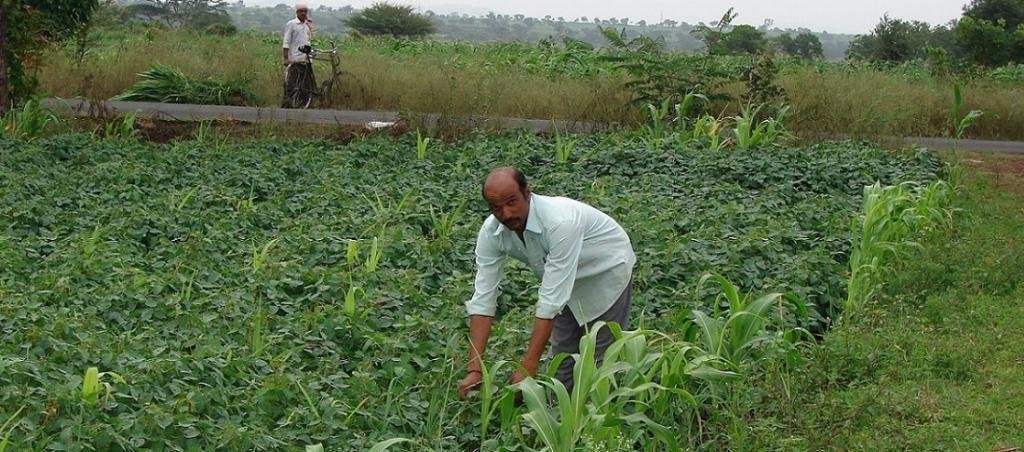
So where do farmers start? Given that the use of chemical fertilizers and pesticides only exacerbate climate change and global warming due to the presence of nitrogen, potassium and phosphorous in them, either natural farming or permaculture (minus the use of animals) is a great method to initiate the soil healing process. Both focus on soil regeneration by using biomass from leaves, grass, twigs, stalks, branches, etc. to create new healthy soil. Both natural farming and permaculture use processes of the decomposition of biomass that replicate the natural process of soil creation in forests with no human interference. Once the soil is ready in just three months, plants and trees can be planted in several layers once again replicating natural forest ecosystems that thrive without fertilizers and pesticides. Farmers who have adopted these methods know that though there is a lot of effort involved in the initial stage, once the natural ecosystems are in place, they don’t need to put in a lot of work as it is a very sustainable way of farming. In just a couple of years or so, these food forests can become permanent sources of food for the farmer and the communities around them while helping the world set itself right again!
